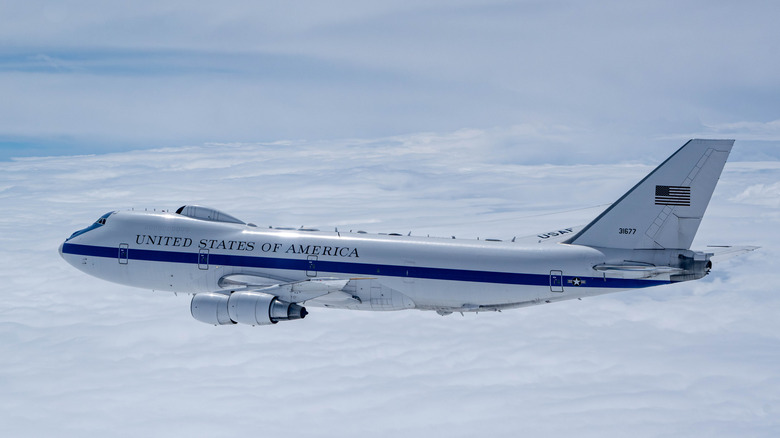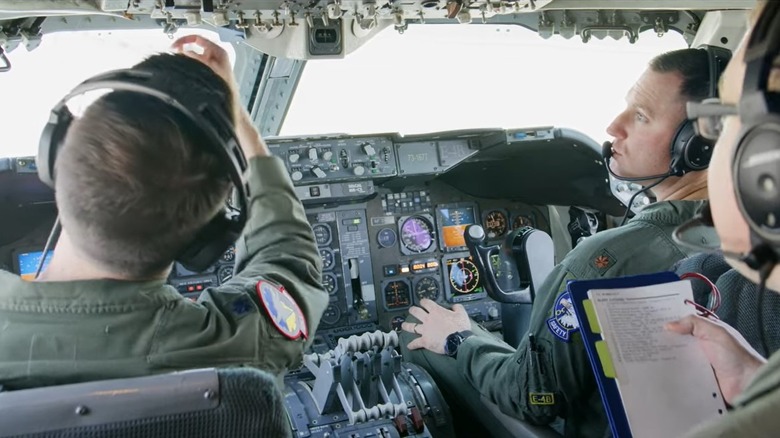E-4B Nightwatch Interior: What Does The Inside Of The Doomsday Plane Look Like?
From the outside, apart from that weird hump, the E-4B Doomsday Plane could be mistaken for a standard Boeing 747, or at least a presidential one. In reality, it's a plane that serves a very specific purpose. The "Doomsday Plane" is an aircraft that is designed to act as a mobile command center or, more officially, as a National Airborne Operations Center (NAOC) for the National Military Command System, a group that includes the President, the Secretary of Defense, and the Joint Chiefs of Staff. The Nightwatch is designed to be deployed during national emergencies. This can include nuclear war and natural disasters, or if ground command and control centers have been destroyed.
The plane is a heavily modified Boeing 747-200 that is crammed full of advanced electronics. To protect these, the plane is shielded against the effects of electromagnetic pulses. Inside, the cabin looks nothing like a commercial 747. Instead, it has seating for 111 people split across six specific areas. These include a conference room, a command area, a briefing room, an operations team area, a communications section, and a rest area. Crewing the plane are the pilots, security personnel, a maintenance crew, a joint-service operations team, and other selected personnel depending on the circumstances. Out of the four available E-4Bs, at least one of them is always designated as the NAOC and is on a 24/7 standby.
Welcome aboard - Inside the E-4B Nightwatch
Greeting you upon boarding the E-4B is a sign that simply says — Welcome Aboard. From there, we make our way to the cockpit. This is one of the civilian jets used by the US military, and the cockpit looks similar to its commercial Boeing 747-200 counterpart, with seating for two pilots, the flight engineer, and a navigator. Situated behind the cockpit is the upper rest room, which has room for up to 18 crew. There's an additional crew rest area at the rear of the jet.
Situated below the flight deck is the senior leader compartment, which has a VIP office and room for four security personnel. Behind this is the sound-dampened conference room, which has room to accommodate up to 9 senior leaders. Directly behind this is the briefing room. Because the plane is occasionally used by the Secretary of Defense for foreign travel, this room is there to allow press briefings.
The battle staff room is in the center of the plane, which is staffed by up to 30 military personnel with an understanding of the country's strategic situation and a knowledge of state and national infrastructure. These are the sections of the aircraft that house the leaders and personnel tasked with dealing with whatever emergency is being faced. However, staying up to date with the situation on the ground is essential if the right decisions are to be made. The communications and technical control room plays a central part in this.
Staying informed - Inside the E-4B's communication hub
Making the right decisions requires having the right information at your fingertips. Helping to ensure that the critical personnel aboard the Nighthawk remain informed is controlled from the communications and technical control center. Situated between the battle staff area and the rear crew rest area, this section of the aircraft is crammed full of electronics. It includes a secure radio compartment for — you guessed it — secure communications. It also has a "clear side" radio room that handles non-secure communications, including with other aircraft and air traffic control. Additionally, there's a satellite communications station that uses the weird hump on the top of the Doomsday plane for secure satellite communications using the Milstar and AEHF satellite systems.
There is also a monitoring station for the very-low frequency radio system, which can be used to communicate with ballistic missile submarines. This uses a trailing antenna that is stored on a giant spool. When deployed, this can stretch out behind the plane for up to five miles, and needs to be monitored continuously to watch for damage caused by turbulence or adverse weather conditions. Finally, this section of the Doomsday plane is where the aircraft's vital onboard power and cooling systems are managed.
Ultimately, the E-4B is designed to be a highly-survivable mobile command center that is designed to keep America's leaders in control, even on the worst imaginable day.

